Hydraulic Conductivity and Pore Water Pressures in a Clayey Landslide: Experimental Data
Abstract
1. Introduction
2. Costa della Gaveta Landslide
3. Field Tests to Evaluate Hydraulic Conductivity
3.1. Localized Seepage Measurements in Pumping Wells
3.2. Falling Head Tests in Casagrande Piezometers
4. Pore Water Pressures and Displacement Rate
5. Discussion and Conclusions
Author Contributions
Funding
Acknowledgments
Conflicts of Interest
References
- Guida, G.; Iaccarino, G. Fasi evolutive delle frane tipo colata nell’alta valle del F.Basento (Potenza). Proc. Studi Trentini di Scienze Naturali, Acta Geol. 1991, LCVIII, 127–152. [Google Scholar]
- Urciuoli, G.; Comegna, L.; Di Maio, C.; Picarelli, L. The Basento Valley: A natural laboratory to understand the mechanics of earthflows. Riv. Ital. Di Geotec. 2016, 50, 71–90. [Google Scholar]
- Pescatore, T.; Renda, P.; Tramutoli, M. Rapporti tra le unità lagonegresi e le unità sicilidi nella media valle del Basento, Lucania (Appennino Meridionale). Mem. Soc. Geol. IT. 1988, 41, 353–361. [Google Scholar]
- Brunsden, D. Some geomorphological considerations for the future development of landslide models. Geomorphology 1999, 30, 13–24. [Google Scholar] [CrossRef]
- Shao, W.; Bogaard, T.; Bakker, M.; Berti, M. The influence of preferential flow on pressure propagation and landslide triggering of the Rocca Pitigliana landslide. J. Hydrol. 2015, 543, 360–372. [Google Scholar] [CrossRef]
- Bogaard, T.A.; Greco, R. Landslide hydrology: From hydrology to pore pressure. Wires Water 2016, 3, 439–459. [Google Scholar] [CrossRef]
- Belle, P.; Aunay, B.; Lachassagne, P.; Ladouche, B.; Join, J.-L. Control of tropical landcover and soil properties on landslides’ aquifer recharge, piezometry and dynamics. Water 2018, 10, 1491. [Google Scholar] [CrossRef]
- Sidle, R.C.; Greco, R.; Bogaard, T.A. Overview of Landslide Hydrology. Water 2019, 11, 148. [Google Scholar] [CrossRef]
- Hencher, S.R. Preferential flow paths through soil and rock and their association with landslides. Hydrol. Process. 2010, 24, 1610–1630. [Google Scholar] [CrossRef]
- Sharma, R.; Nakagawa, H. Numerical model and flume experiments of single and two-layered hillslope flow related to slope failure. Landslides 2010, 7, 425–432. [Google Scholar] [CrossRef]
- Krzeminska, D.M.; Bogaard, T.A.; Malet, J.P.; van Beek, L.P.H. A model of hydrological and mechanical feedbacks of preferential fissure flow in a slowmoving landslide. Hydrol. Earth Syst. Sci. 2013, 17, 947–959. [Google Scholar] [CrossRef]
- Vitone, C.; Cotecchia, F. The influence of intense fissuring on the mechanical behaviour of clays. Géotechnique 2011, 61, 1003–1018. [Google Scholar] [CrossRef]
- Cotecchia, C.; Vitone, C.; Santaloia, F.; Pedone, G.; Bottiglieri, O. Slope instability processes in intensely fissured clays: Case histories in the Southern Apennines. Landslides 2015, 12, 877–893. [Google Scholar] [CrossRef]
- Tagarelli, V.; Cotecchia, F. The Effects of Slope Initialization on the Numerical Model Predictions of the Slope-Vegetation-Atmosphere Interaction. Geosciences 2020, 10, 85. [Google Scholar] [CrossRef]
- Ruggeri, P.; Fruzzetti, V.M.E.; Scarpelli, G. Design Strategies to Mitigate Slope Instabilities in Structurally Complex Formations. Geosciences 2020, 10, 82. [Google Scholar] [CrossRef]
- Ruggeri, P.; Fruzzetti, V.M.E.; Ferretti, A.; Scarpelli, G. Seismic and Rainfall Induced Displacements of an Existing Landslide: Findings from the Continuous Monitoring. Geosciences 2020, 10, 90. [Google Scholar] [CrossRef]
- Di Maio, C.; Vassallo, R.; Vallario, M.; Pascale, S.; Sdao, F. Structure and kinematics of a landslide in a complex clayey formation of the Italian Southern Apennines. Eng. Geol. 2010, 116, 311–322. [Google Scholar] [CrossRef]
- Vassallo, R.; Grimaldi, G.M.; Di Maio, C.; Di Nocera, S. An earthflow in structurally complex formations of the Italian Southern Apennines: Geological structure and kinematics. In Proceedings of the 12th International Symposium on Landslides, Naples, Italy, 12–19 June 2016; Aversa, S., Cascini, L., Picarelli, L., Scavia, C., Eds.; CRC Press: Boca Raton, FL, USA, 2016; Volume 2, pp. 813–820. [Google Scholar]
- Selli, R. II Paleogene nel quadro della geologia dell’Italia centro meridionale. Mem. Soc. Geol. IT. 1962, 3, 737–789. [Google Scholar]
- Summa, V. Final Report of the Project “Monitoring of Costa DELLA GAVETA Landslide in Potenza”, in Italian; CNR-IMAA: Tito, Italy, 2006. [Google Scholar]
- Scaringi, G.; Di Maio, C. Residual shear strength of clayey soils: The influence of displacement rate. In Proceedings of the 2nd Conference for PhD students in Civil Engineering, Cluj-Napoca, Romania, 10–13 December 2014; UT Press: Cluj-Napoca, Romania, 2014; Volume 1, pp. 325–332. [Google Scholar]
- Scaringi, G.; Di Maio, C. Influence of displacement rate on residual shear strength of clays. Procedia Earth Planet. Sci. 2016, 16, 137–145. [Google Scholar] [CrossRef]
- Calcaterra, S.; Di Maio, C.; Gambino, P.; Vallario, M.; Vassallo, R. Surface displacements of two landslides evaluated by GPS and inclinometer systems: A case study in Southern Apennines, Italy. Nat. Hazards 2012, 61, 257–266. [Google Scholar] [CrossRef]
- Vassallo, R.; Calcaterra, S.; De Rosa, J.; Di Maio, C.; Gambino, P. Long-term displacement monitoring of two very slow earthflows by inclinometers, GPS and Cosmo-SkyMed data. Submitted Geosci. 2020. Under Review. [Google Scholar]
- Hungr, O.; Leroueil, S.; Picarelli, L. The Varnes classification of landslide types, an update. Landslides 2014, 11, 167–194. [Google Scholar] [CrossRef]
- Vassallo, R.; Doglioni, A.; Grimaldi, G.M.; Di Maio, C.; Simeoni, V. Relationships between rain and displacements of an active earth flow: A data driven approach by EPRMOGA. Nat. Hazards. 2016, 81, 1467–1482. [Google Scholar] [CrossRef]
- Vassallo, R.; Grimaldi, G.M.; Di Maio, C. Pore water pressures induced by historical rain series in a clayey landslide: 3D modeling. Landslides 2015, 12, 731–744. [Google Scholar] [CrossRef]
- De Rosa, J.; Pontolillo, D.M.; Caputo, V.; Di Maio, C.; Scaringi, G. Evaluation of hydraulic conductivity in the slip zone of an earthflow in clay shales. In Proceedings of the XVII European Conference on Soil Mechanics and Geotechnical Engineering ECSMGE, Reykjavik, Iceland, 1–6 of September 2019; Sigursteinsson, H., Erlingsson, S., Bessason, B., Eds.; ISSMGE Online Library, 2019; pp. 546–552. [Google Scholar]
- Grimaldi, G.M.; Pontolillo, D.M.; De Rosa, J.; Rizzo, E.; Di Maio, C. Modelling water flow and ion transport in clay soils: The case of KCl wells in the head of an earthflow. In Micro to MACRO Mathematical Modelling in Soil Mechanics, Trends in Mathematics; Giovine, P., Mariano, P.M., Mortara, G., Eds.; Birkhauser: Basel, Switzerland, 2018; pp. 159–167. [Google Scholar]
- Hvorslev, M.J. Time lag and soil permeability in ground-water observations.Waterways experimentary station. Corps of Engineers, US Army. Vicksburg, Mississipi. Bulletin 1951, 36, 50. [Google Scholar]
- Di Maio, C.; Vassallo, R.; Vallario, M. Plastic and viscous shear displacements of a deep and very slow landslide in stiff clay formation Eng. Geol. 2013, 162, 53–66. [Google Scholar]
- Kenney, T.C.; Lau, K.C. Temporal changes of groundwater pressure in a natural slope of nonfissured clay. Can. Geotech. J. 1984, 21, 138–146. [Google Scholar] [CrossRef]
- Conte, E.; Troncone, A. Soil layer response to pore pressure variations at the boundary. Géotechnique 2008, 58, 37–44. [Google Scholar] [CrossRef]
- Conte, E.; Troncone, A. Stability analysis of infinite clayey slopes subjected to pore pressure changes. Géotechnique 2012, 62, 87–91. [Google Scholar] [CrossRef]
- Urciuoli, G.; Pirone, M.; Comegna, L.; Picarelli, L. Long-term investigations on the pore pressure regime in saturated and unsaturated sloping soils. Eng. Geol. 2016, 212, 98–119. [Google Scholar] [CrossRef]
- Di Maio, C.; Vassallo, R. Geotechnical characterization of a landslide in a Blue Clay slope. Landslides 2011, 8, 17–32. [Google Scholar] [CrossRef]
- Di Maio, C.; Scaringi, G.; Vassallo, R. Residual strength and creep behaviour on the slip surface of specimens of a landslide in marine origin clay shales: Influence of pore fluid composition. Landslides 2015, 12, 657–667. [Google Scholar]
- Di Maio, C.; Scaringi, G. Shear displacements induced by decrease in pore solution concentration on a pre-existing slip surface. Eng. Geol. 2016, 200, 1–9. [Google Scholar] [CrossRef]
- Di Maio, C.; Vassallo, R.; Scaringi, G.; De Rosa, J.; Pontolillo, D.M.; Grimaldi, G.M. Monitoring and analysis of an earthflow in tectonized clay shales and study of a remedial intervention by KCl wells. Riv. Ital. Di Geotec. 2017, 51, 48–63. [Google Scholar]
- Scaringi, G.; Pontolillo, D.M.; De Rosa, J.; Di Maio, C.; Caputo, V. Variations of Na+ and K+ concentrations in the pore fluid of a clayey soil affected by landslides: Effects on shear strength and creep behaviour. In Proceedings of the XVII European Conference on Soil Mechanics and Geotechnical Engineering ECSMGE, Reykjavik, Iceland, 1–6 September 2019; Sigursteinsson, H., Erlingsson, S., Bessason, B., Eds.; ISSMGE Online Library, 2019; pp. 1038–1044. [Google Scholar]
- De Rosa, J.; Pontolillo, D.M.; Di Maio, C.; Vassallo, R. Chemical clay soil improvement: From laboratory to field test. Procedia Eng. 2016, 158, 284–289. [Google Scholar] [CrossRef]
- Pontolillo, D.M.; De Rosa, J.; Scaringi, G.; Di Maio, C. Clay creep and displacements: Influence of pore fluid composition. Procedia Eng. 2016, 158, 69–74. [Google Scholar] [CrossRef]
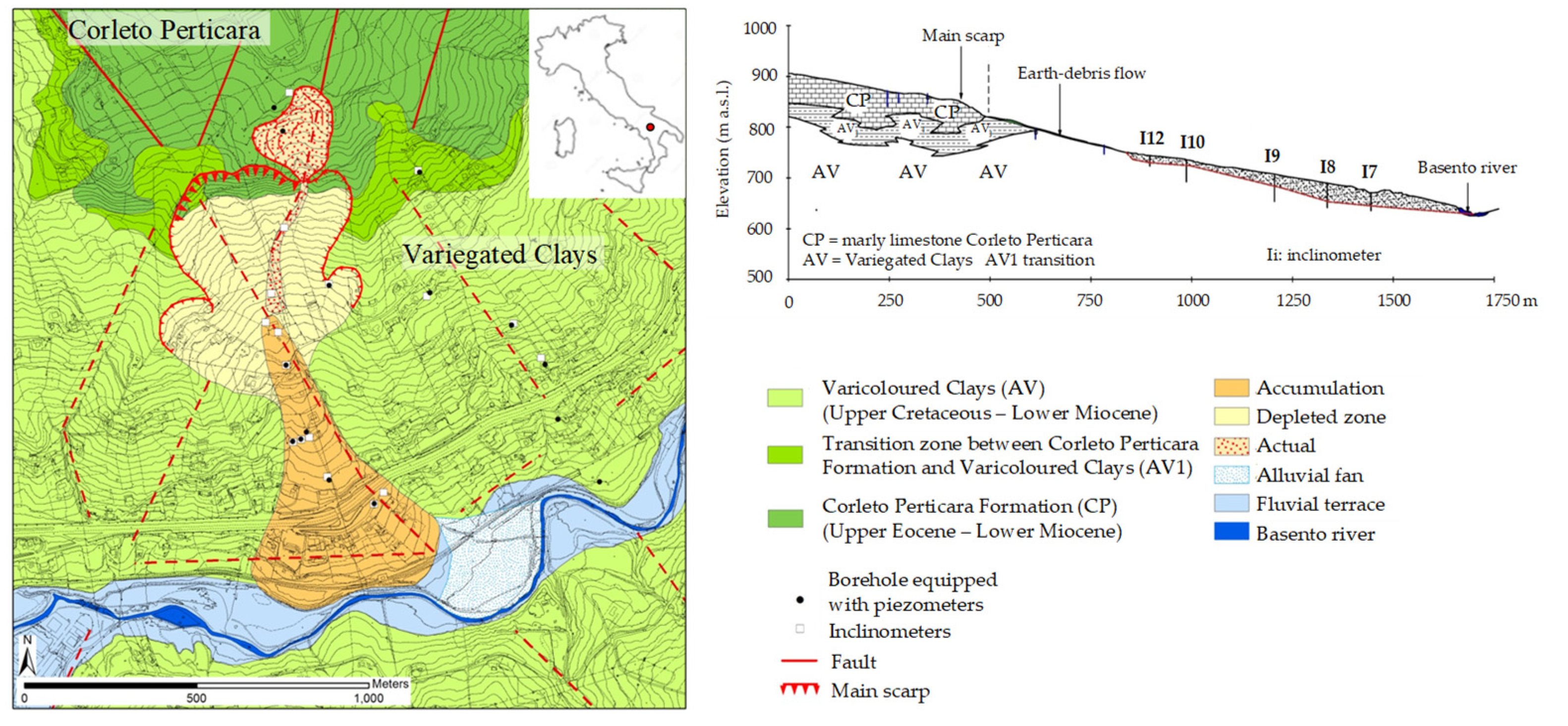
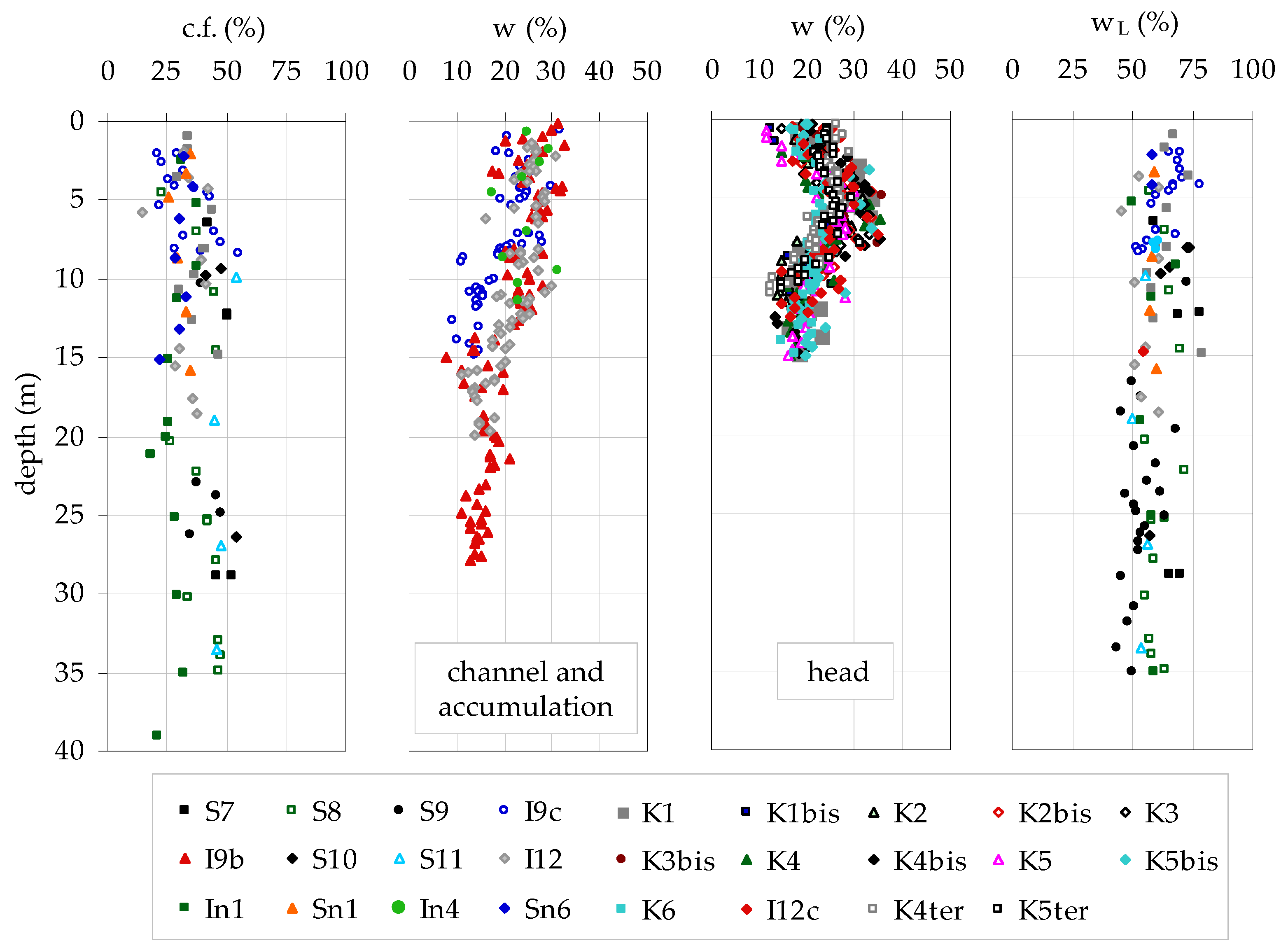
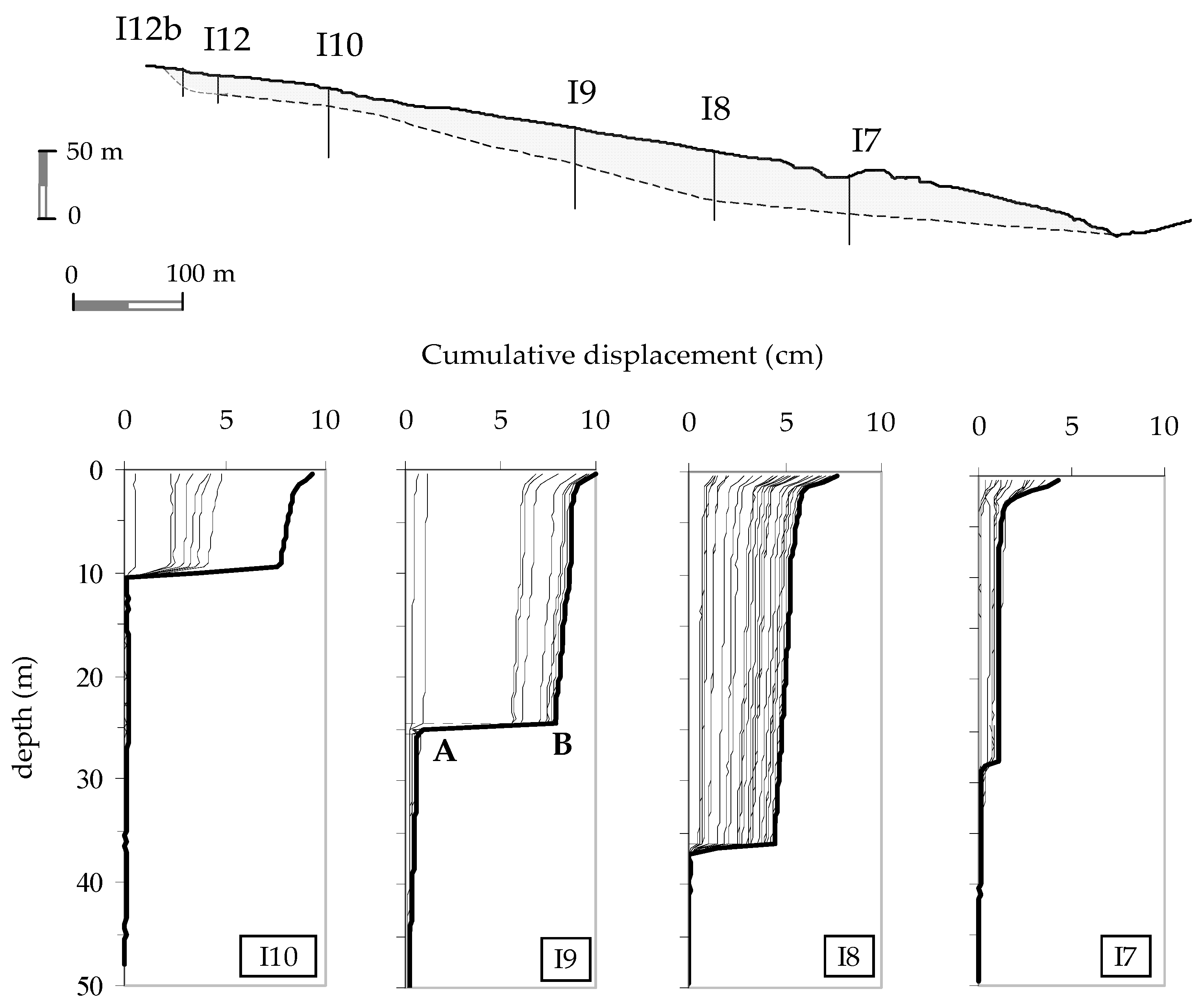

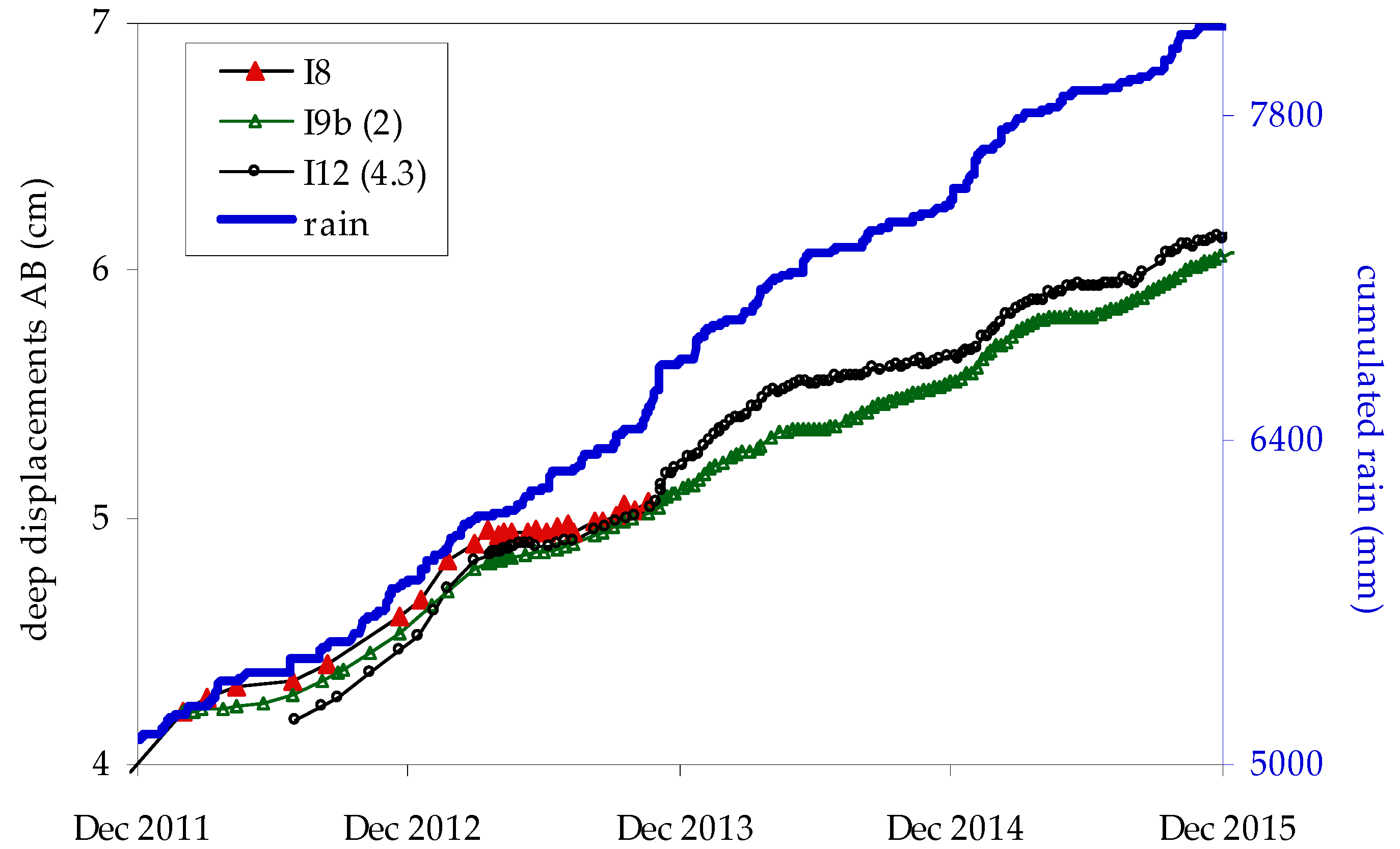
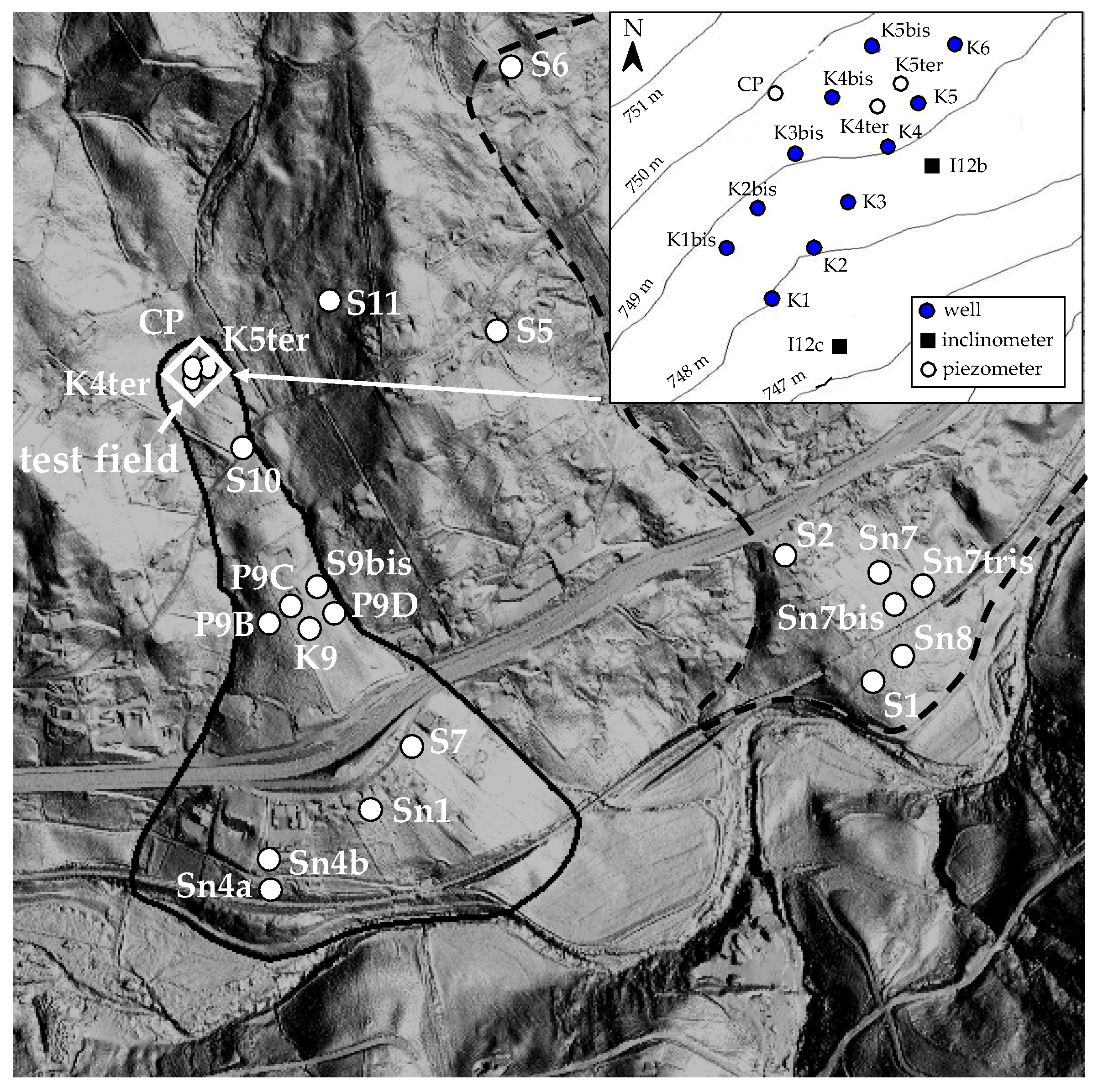
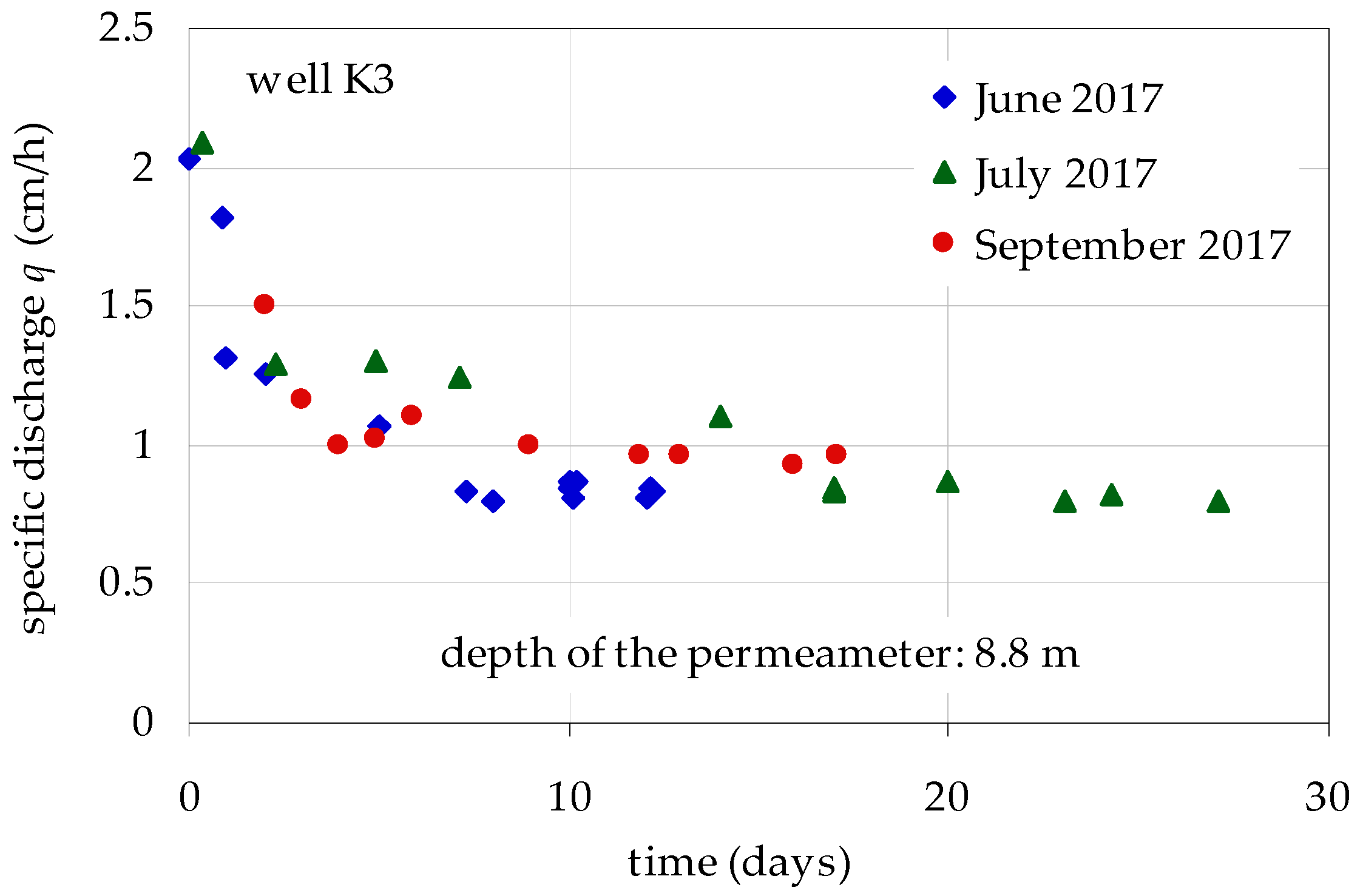
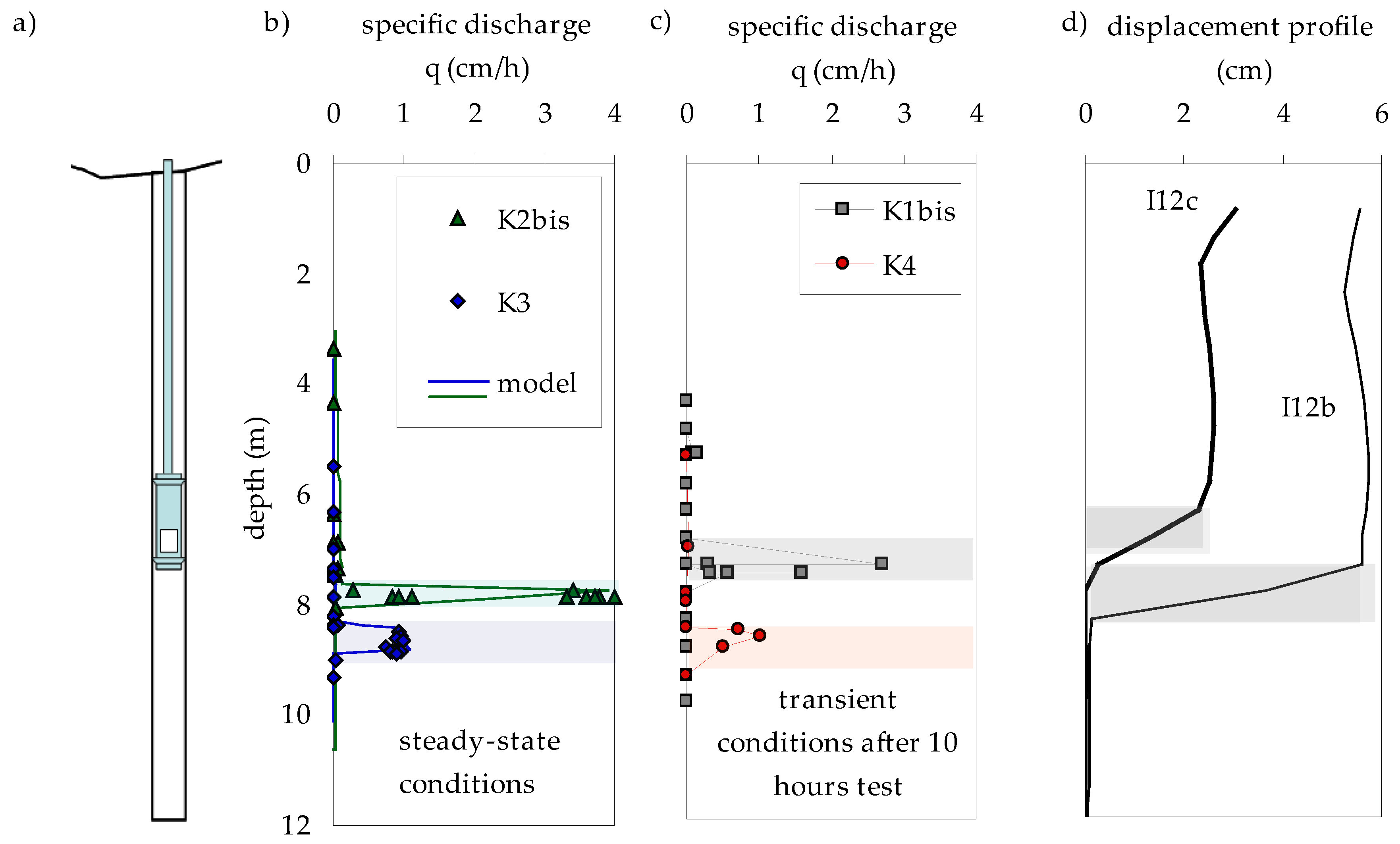
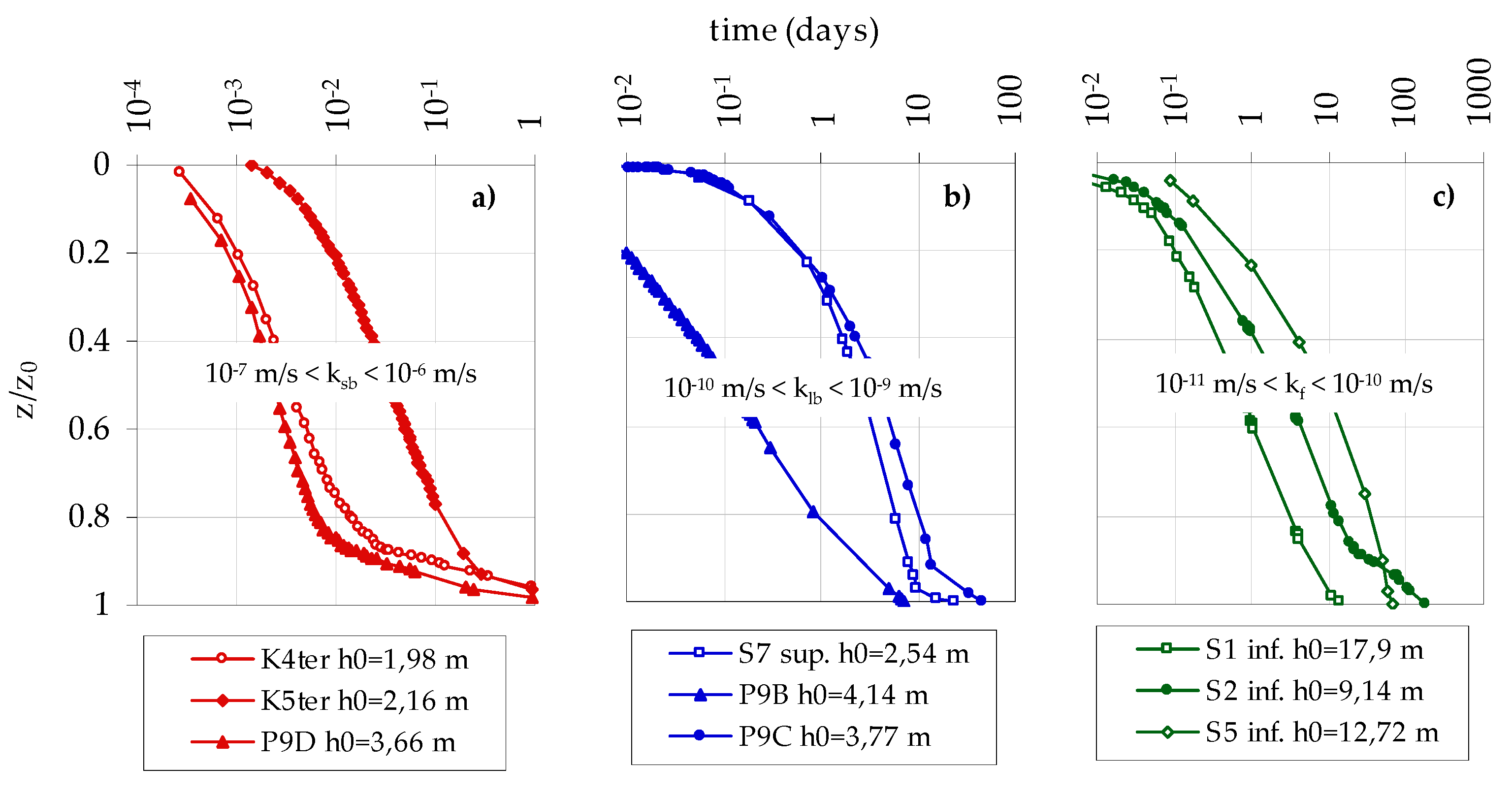

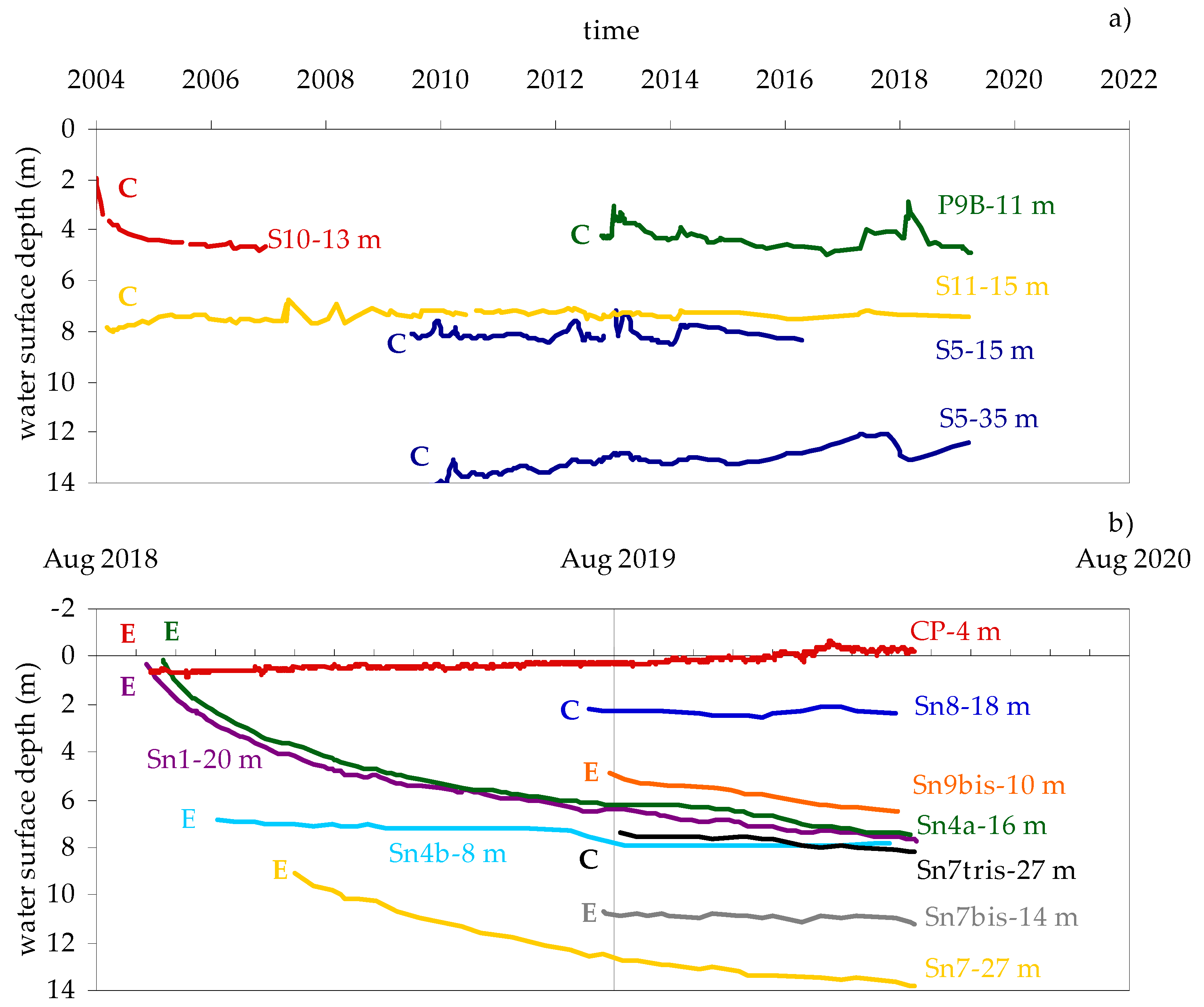
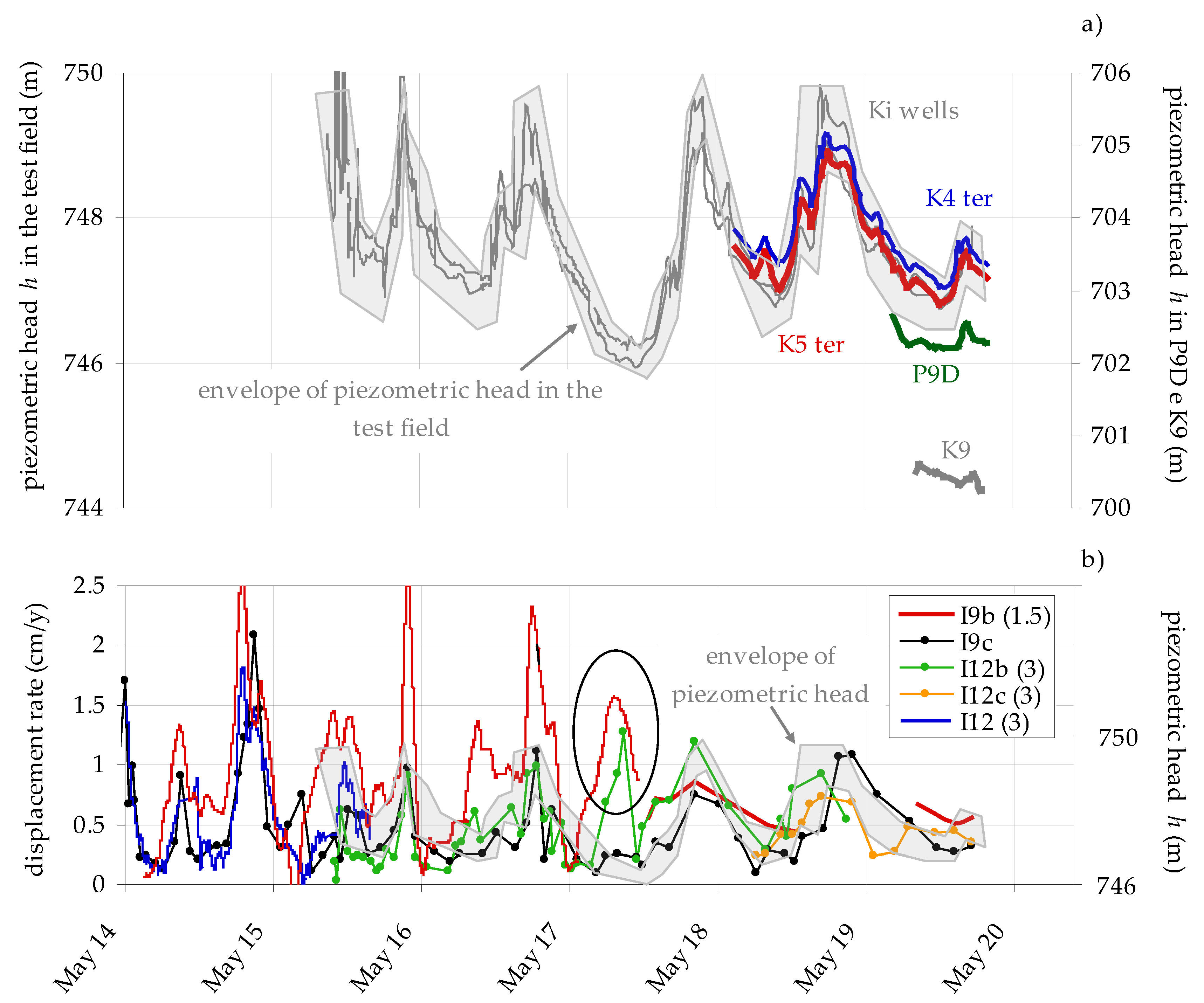
© 2020 by the authors. Licensee MDPI, Basel, Switzerland. This article is an open access article distributed under the terms and conditions of the Creative Commons Attribution (CC BY) license (http://creativecommons.org/licenses/by/4.0/).
Share and Cite
Di Maio, C.; De Rosa, J.; Vassallo, R.; Coviello, R.; Macchia, G. Hydraulic Conductivity and Pore Water Pressures in a Clayey Landslide: Experimental Data. Geosciences 2020, 10, 102. https://doi.org/10.3390/geosciences10030102
Di Maio C, De Rosa J, Vassallo R, Coviello R, Macchia G. Hydraulic Conductivity and Pore Water Pressures in a Clayey Landslide: Experimental Data. Geosciences. 2020; 10(3):102. https://doi.org/10.3390/geosciences10030102
Chicago/Turabian StyleDi Maio, Caterina, Jacopo De Rosa, Roberto Vassallo, Roberto Coviello, and Giuseppe Macchia. 2020. "Hydraulic Conductivity and Pore Water Pressures in a Clayey Landslide: Experimental Data" Geosciences 10, no. 3: 102. https://doi.org/10.3390/geosciences10030102
APA StyleDi Maio, C., De Rosa, J., Vassallo, R., Coviello, R., & Macchia, G. (2020). Hydraulic Conductivity and Pore Water Pressures in a Clayey Landslide: Experimental Data. Geosciences, 10(3), 102. https://doi.org/10.3390/geosciences10030102



